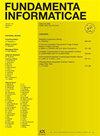Asynchronous Systems of Parallel Communicating Finite Automata
IF 0.4
4区 计算机科学
Q4 COMPUTER SCIENCE, SOFTWARE ENGINEERING
引用次数: 7
Abstract
Synchronous systems of parallel communicating one-way finite automata have already been investigated. There, all components work stepwise in parallel, and the communication between the components is realized by requesting states in a one-directional manner. This means that one component can request information in form of the current state from another component, where the latter one sends its current state without realizing that a communication takes place. Here, we introduce asynchronous systems of parallel communicating one-way and two-way finite automata with a bidirectional communication protocol. A communication only takes place, when both components-the requesting and the responding component-are ready to communicate. It is shown that almost all language classes that are characterized by these systems coincide with the language classes that are characterized by multi-head finite automata. Moreover, our communication protocol uses blocking point-to-point communications, i.e. a communication takes place between two components, and a communicating component is blocked until the communication has been finished. There have also been studied asynchronous systems of finite automata with non-blocking communication in the literature. Thus, we compare synchronous and asynchronous systems on the one hand and asynchronous systems with blocking and non-blocking communication on the other hand. Finally, we give some results on the communication complexity of our systems, where the amount of communication is measured by counting each message which is sent from one component to another during a computation of a system. Particularly, we show that with constantly many communications our systems can only accept regular languages, and at most linearly (polynomially) many communications are needed for systems of one-way (two-way) components depending on the length of the input. Further, there exists no system that executes more than constantly many and less than linearly many communications.并行通信有限自动机的异步系统
并行通信单向有限自动机的同步系统已经得到了研究。在那里,所有组件并行地逐步工作,组件之间的通信通过以单向方式请求状态来实现。这意味着一个组件可以从另一个组件请求当前状态形式的信息,后者发送其当前状态,而不会意识到发生了通信。本文介绍了一种具有双向通信协议的单向和双向有限自动机并行通信异步系统。只有当两个组件(请求组件和响应组件)都准备好进行通信时,才会进行通信。结果表明,几乎所有以这些系统为特征的语言类都与以多头有限自动机为特征的语言类相吻合。此外,我们的通信协议使用阻塞点对点通信,即在两个组件之间进行通信,并且通信组件被阻塞直到通信完成。文献中也研究了具有非阻塞通信的有限自动机异步系统。因此,我们一方面比较同步和异步系统,另一方面比较具有阻塞和非阻塞通信的异步系统。最后,我们给出了系统通信复杂性的一些结果,其中通信量是通过计算系统计算期间从一个组件发送到另一个组件的每条消息来衡量的。特别是,我们表明,随着不断的许多通信,我们的系统只能接受常规语言,并且根据输入的长度,单向(双向)组件的系统最多需要线性(多项式)许多通信。此外,不存在执行多于恒定多通信和少于线性多通信的系统。
本文章由计算机程序翻译,如有差异,请以英文原文为准。
求助全文
约1分钟内获得全文
求助全文
来源期刊

Fundamenta Informaticae
工程技术-计算机:软件工程
CiteScore
2.00
自引率
0.00%
发文量
61
审稿时长
9.8 months
期刊介绍:
Fundamenta Informaticae is an international journal publishing original research results in all areas of theoretical computer science. Papers are encouraged contributing:
solutions by mathematical methods of problems emerging in computer science
solutions of mathematical problems inspired by computer science.
Topics of interest include (but are not restricted to):
theory of computing,
complexity theory,
algorithms and data structures,
computational aspects of combinatorics and graph theory,
programming language theory,
theoretical aspects of programming languages,
computer-aided verification,
computer science logic,
database theory,
logic programming,
automated deduction,
formal languages and automata theory,
concurrency and distributed computing,
cryptography and security,
theoretical issues in artificial intelligence,
machine learning,
pattern recognition,
algorithmic game theory,
bioinformatics and computational biology,
quantum computing,
probabilistic methods,
algebraic and categorical methods.
 求助内容:
求助内容: 应助结果提醒方式:
应助结果提醒方式:


